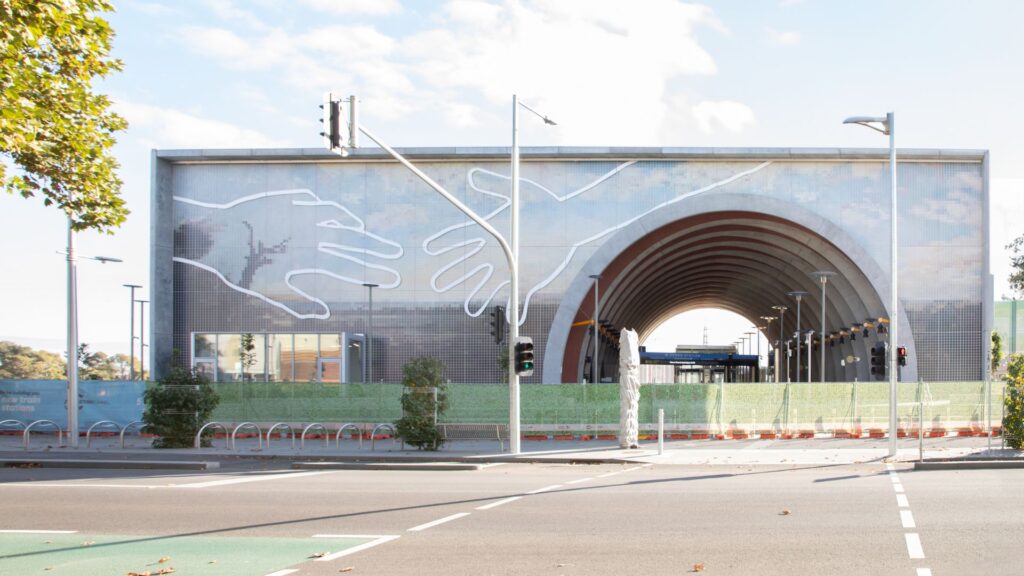
In the bustling heart of Melbourne, a remarkable transformation is taking place at Arden Station. This railway station is not only a hub for commuters but also a silent warrior against urban pollution. Thanks to the innovative Active Surfaces® by Iris Ceramica Group, the station’s façade actively purifies the air, kills viruses, and maintains its pristine appearance using nothing more than sunlight and humidity.
The technology behind this environmental marvel is developed by Fiandre, Iris Ceramica Group’s premium architectural brand, which produces the Active Surfaces® ceramic slabs. These surfaces are not just decorative; they are engineered to contribute significantly to urban air quality.
The Artistic Vision Behind Arden Station
The architectural story of Arden Station is as compelling as its environmental impact. Artist Abdul Abdullah envisioned transforming J.S. Calder’s 1860 painting, “View from Royal Park across West Melbourne Swamp,” into a contemporary masterpiece. The artwork, featuring two massive aluminum hands reaching towards each other, symbolizes the station as a convergence point for diverse cultures and generations. This theme not only celebrates Melbourne’s multicultural identity but also underscores the role of public infrastructure as a mediator of collective identity.
What sets this artwork apart is its integration into the station’s structure. Printed on Active Surfaces® ceramic slabs, the art spans the station’s eastern wall, where it silently works to break down air pollutants, neutralize odors, and eliminate harmful microorganisms.
How Active Surfaces® Work
The secret to these “active” ceramic surfaces lies in a decade of research conducted in collaboration with the University of Milan’s Department of Chemistry. The surfaces are made of photocatalytic materials that use both natural and artificial light to trigger continuous chemical reactions. When light hits the surface, it activates a process that breaks down nitrogen oxides, common pollutants emitted by vehicles and industrial activities.
Tests indicate that the Arden Station’s façade can degrade 6.5 kilograms of nitrogen oxides annually, equating to the air-cleaning capacity of 9,600 square meters of green space.
This means every slab of Active Surfaces® functions like a micro-garden, enhancing the city’s air quality without the need for land, irrigation, or maintenance.
A Sustainable and Self-Cleaning Solution
The Arden Station features 522 square meters of Uni-Ice Maximum natural slabs, while the building’s distinctive artwork is realized on Maximum Active Surfaces© big panels. The west façade spans 590 square meters, clad with customized Active Surfaces® slabs measuring 300×150 cm. In total, the station boasts over 1,100 square meters of these innovative surfaces, effectively creating a vertical urban park.
Beyond fighting pollution, Active Surfaces® offer significant antimicrobial benefits. The same photocatalytic process that tackles nitrogen oxides also dismantles the molecular structure of harmful viruses and bacteria. Research from the University of Milan shows that 94% of SARS-CoV-2 particles are eliminated within four hours of light exposure, alongside other pathogens like E. Coli and Poliovirus.
Melbourne’s unpredictable weather further enhances the façade’s functionality. The Active Surfaces® technology induces a hydrophilic effect, causing water to spread evenly across the surface rather than forming droplets. This creates a self-cleaning effect where rainwater washes away dirt and grime, reducing the need for chemical cleaners and labor-intensive maintenance.
Innovative Manufacturing and Environmental Impact
One of the challenges in constructing Arden Station was replicating Abdul Abdullah’s artwork on the façade. This was achieved using Iris Ceramica Group’s Design Your Slabs (DYS) technology, allowing for the customization of ceramic surfaces with any image or illustration. The result is a seamless integration of art and architecture, with the artwork becoming an intrinsic part of the building rather than an afterthought.
The manufacturing process reflects Iris Ceramica Group and Fiandre’s commitment to sustainability. Active Surfaces® incorporate at least 40% recycled materials and are fully recyclable, ensuring that they give back to the environment even at the end of their lifecycle. The eco-active properties are embedded directly into the ceramic structure, ensuring long-lasting effectiveness without diminishing over time.
As cities worldwide grapple with pollution and public health challenges, Melbourne’s Arden Station stands as a beacon of innovation and sustainability. The integration of Active Surfaces® not only enhances urban air quality but also sets a precedent for future infrastructure projects. As cities continue to grow, such innovative solutions could play a crucial role in creating healthier, more sustainable urban environments.





